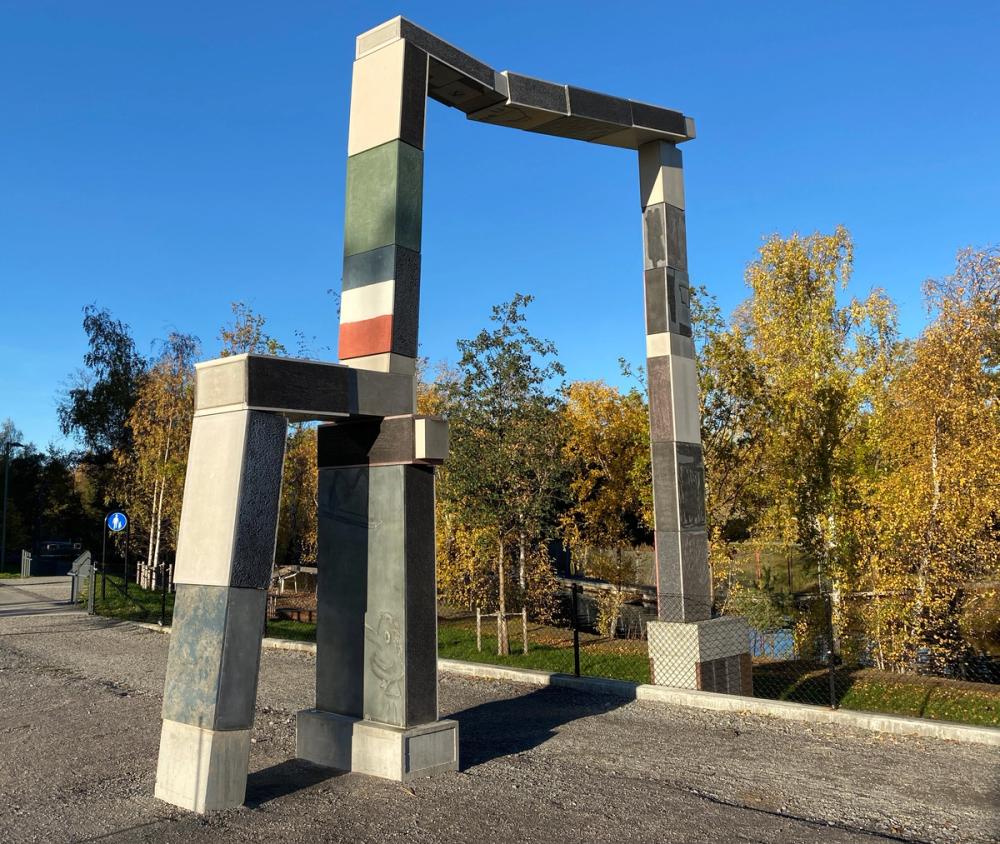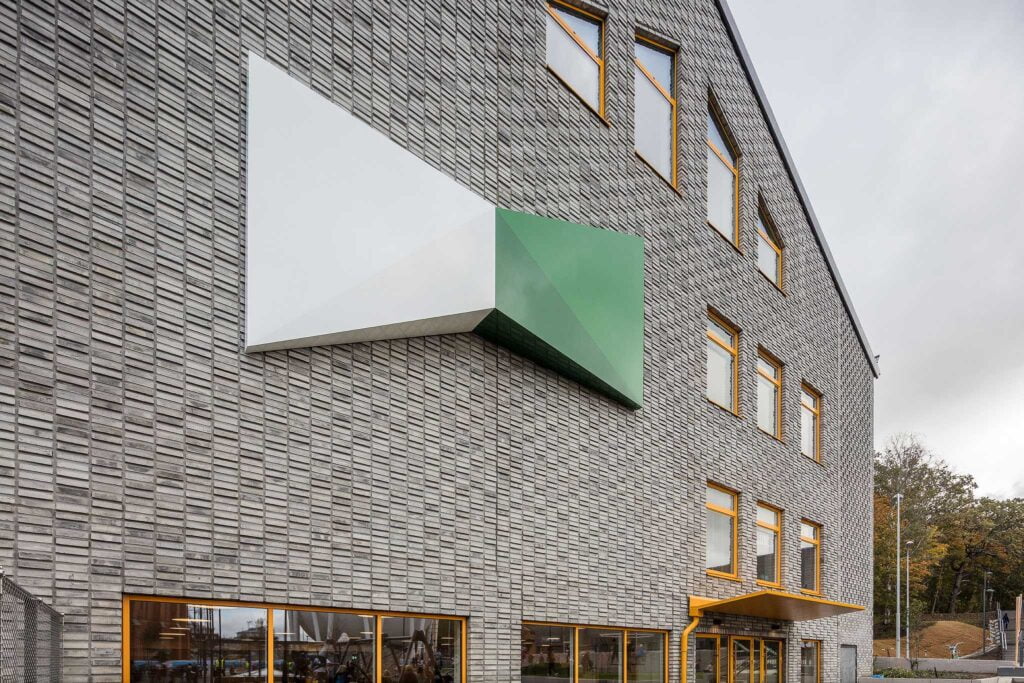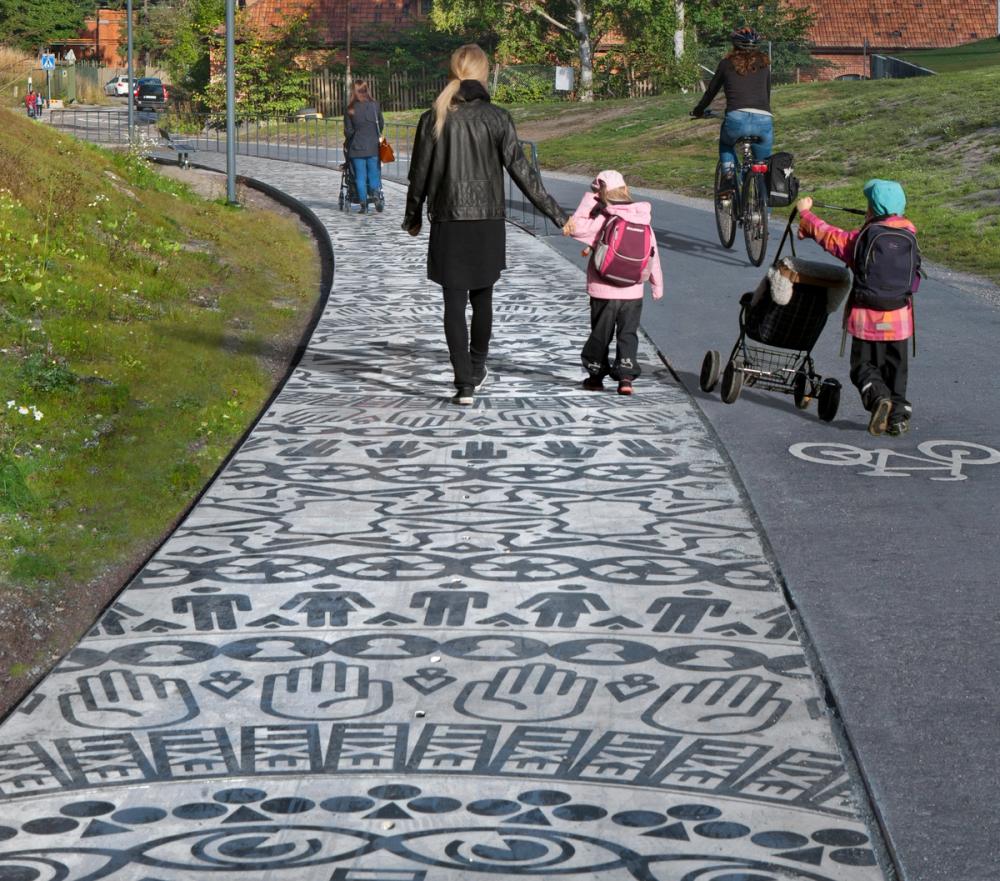Discover the public art in Stockholm Royal Seaport
Public art, made possible by the one percent rule, plays a significant role in the urban development in Stockholm. Artworks in parks, squares, and public buildings contribute to a diversity of experiences that enhance the identity of the place and reflect its history, conditions, and future.
Stefan Hagdahl, head of Stockholm Konst (Stockholm Art), emphasizes the importance of art in public spaces:
Public art is vital and is created for all Stockholm residents and visitors. It can spark curiosity and foster new thoughts and experiences. It can also create an identity for a place and become a landmark that serves as a point of orientation.
The artwork Triumfbåge för halta (Triumphal Arch for the Mobility-Impaired) serves as the starting point for a digital art tour of various works around Gasverket. There is also a tour that highlights works in and around the Värtan Terminal.
Come for a walk with us

1
Triumfbåge för halta
A wobbling construction made from matchboxes is given new life in concrete treated in an experimental manner. The sculpture, Triumfbåge för halta (Triumphal Arch for the Mobility-Impaired), is a tribute to everyday heroes and the beauty in the inconspicuous.
Matchboxes hold a special place in Jockum Nordström’s work – a humble artistic material for simple constructions without glue. Over time, these structures have evolved into abstract compositions.
Triumfbåge för halta is a cunning allusion to the Roman monuments constructed in honour of victorious generals. Nordström challenges conventional beauty ideals through a playful deconstruction of the classical motif in his artistic interpretation. He subverts norms by presenting the large arch alongside only a smaller part of its construction.
In his creation of the standalone portal building, he integrates graffiti and cartoon figures that are directly engraved into the concrete. This gives a sense that the impressive and seemingly unstable structure originates from folded paper sheets and small pencil drawings.

2
Window Reflections (Part 1, Part 2)
The school, Bobergsskolan, stands proudly amidst a fascinating, well-preserved industrial landscape around the brick gasometers in Stockholm Royal Seaport. Anders Sletvold Moe's installation, Window Reflections (Part 1, Part 2), for Bobergsskolan connects with the facade of the newly built building B and the industrial gasworks area.
The artwork draws attention to both the concrete and symbolic aspects of its name. The impressive relief form, placed on the school's facade by artist Sletvold Moe, adopts an open design and can be interpreted as a logo for the school. When sunlight hits the white aluminium structure and the green wood, it creates fascinating reflections. The green colour evokes thoughts of the school’s focus on nature and science.
The same shape used in the relief recurs in a concrete sculpture that the artist has created for the lower schoolyard. This sculpture serves as a seating area, play area, or ramp and acts as a meeting place for the students. LED lighting beneath the sculpture contributes to a special atmosphere in the dark.
These two works, based on the same form but interpreted from different perspectives, create a visual link between the upper and lower schoolyards, artistically unifying the school environment.

3
Light House Io
The redevelopment of Hjorthagens IP (Hjorthagens sports ground) was complete when sculptor Elle Klarskov Jørgensen was commissioned to develop an artistic proposal for the site. She was given the freedom to choose the location within the area for her artwork. In her work, she had to consider both the elongated, warm orange-red new office building by Cedervall Architects and Gunilla Klingberg’s then-unfinished artwork Vardagslivets gång (Everyday Life's Path) on the adjacent bicycle lane.
The artist, who has long worked at the intersection of architecture, art, and everyday life, found strong inspiration in architect Ferdinand Boberg’s gasometers from 1893 and has created a kind of counterpart to them: a cylindrical structure with a cone-shaped roof and multiple openings. The exterior’s graphite shimmering grey and neon red colour scheme forms horizontal lines that flirt with Boberg’s vertical markings of red-orange brick and grey plaster. Inside, the structure radiates in bright red, illuminating its surroundings even when the sports ground is closed.
The structure does not serve any immediate purpose. It is rather fictional, a mimicry of architecture. Its placement on the foundation gives the impression that it is about to slide off, as if it has just landed or is ready to lift from the ground. Perhaps to Jupiter? The sculpture borrows its name from Io, the third largest moon of the planet Jupiter.

4
Vardagslivets gång
The concept for Vardagslivets gång (Everyday Life's Path) emerged from the idea of the route as a journey in several senses. It represents a physical walking path between two points, but also a walk as a time for thoughts to flow freely, where footsteps can follow a rhythm in the pattern like a meditation.
The artist Gunilla Klingberg took on the task of shaping the approximately 500-metre-long pedestrian and bicycle path that extends from the Hjorthagen metro station entrance to the gasometers by Husarviken. The purpose was to connect the new urban development area with the existing surroundings of Stockholm's gasworks. The project required the artwork to meet several technical and functional demands: the path needed to be easy to sweep and shovel, and the pattern had to be user-friendly for people with disabilities.
Klingberg designed a pattern of symbols and pictograms familiar to us all in daily life: keyholes, exit signs, recycling symbols, and similar. The pattern was created through intarsia of black granite stones, set into 178 concrete slabs that had been treated with concrete and polished to ensure slip resistance. At the same time, she integrated the pattern into a mandala, a circular symbol representing the cosmos and eternity, which has become central to her artistic work. We walk, and life goes on.

5
108 källor
The 10-metre-tall and 12-tonne cylinder, 108 källor (sources) forms a visual gateway from Stockholm Royal Seaport to the Royal National City Park across Husarviken.
The Artist Eva Löfdahl was tasked with creating an entrance from Stockholm Royal Seaport to the Royal National City Park, located at the junction of Jaktgatan and Husarviksgatan, where Husarviksparken serves as a breathing space between residential buildings. Husarviken and the greenery of the Royal National City Park are just a short walk away from Löfdahl’s monumental sculpture, with Ferdinand Boberg’s iconic brick gasometers nearby.
The sculpture comprises six 'bundle pillars' with 18 rods each, spanning between top and bottom plates. The rods vary in material, thickness, and finish. Some are made of stainless steel and reflect the surrounding light and colours in vertical stripes. Others are bronze tubes with various surface treatments and might be thickened or jointed to mimic blades of grass or bamboo.
The sculpture’s fabrication required innovative thinking and precise calculations for the different movements of the materials and their anchoring. The artist views the bundle of rods as a representation of parallel events and characteristics, a 'three-dimensional score'.

6
Fy & Bi, House, Midas, Poeten, Pusher och Demonstranten
In Hästhagsparken, there are eight bronze sculptures by Kirsten Ortwed: Midas, Poeten (the Poet), Demonstranten (the Demonstrator), Pusher,Fy & Bi and House. These artworks are intended to provoke visitors to reflect on significant questions and themes related to life, nature, and society. The myth of King Midas tells of a king who wished that everything he touched would turn to gold. His wish was granted, but he soon realised it was a curse as he could no longer eat, symbolising how human pursuit of wealth and material values can lead astray.
Ortwed mysteriously combines organic and artificial forms in her constellation. The largest work is seven meters high and eight meters long, while the other sculptures vary in height from 90 cm to three meters. At first glance, the art appears rooted in the ground, yet it subtly signals something elusive, suggesting an alliance between nature and culture, a fusion of organic development and artistic creation.

7
Water Pavilion
From four circles in the ground at Storängstorget, the Water Pavilion sprays water to form walls that oscillate between high and low following a predetermined choreography. Passersby can enjoy the water display from a distance, but can also interact and enter the artwork. It is certainly a favorite among children during the warmer months of the year. Artist Jeppe Hein aims to make art a part of everyday life where the audience can play an active role.
Hein's artistic vision is characterized by playfulness and innovation, with the intention of integrating art into daily life. His installations often encourage active participation from the audience. The water jets are divided into nine segments that move in various patterns, and in some places, high jets create a calm and meditative environment, while rapid changes in other parts of the pavilion invite visitors to engage in the playful water game. The jets reach up to 2.30 meters high, and after each choreographed sequence, the loop repeats. The water is collected and filtered in a pump house. The fountain is turned off at night and during the winter.

8
Theo
At the intersection of Bobergsgatan and Madängsgatan, the poodle Theo by artist Johanna Karlsson awaits visitors. The work commemorates the Dog Shelter, Swedish Dog Protection Association, which operated for 90 years until 2005, caring for rescued dogs nearby before the facility moved to Åkeshov.
Over the years, the Dog Shelter has been a sanctuary for tens of thousands of dogs that for various reasons could not stay with their owners. The focus here is on finding new, loving homes for these needy dogs, giving them a second chance in life.
The artwork has a special ability to touch the hearts of animal lovers. Theo represents not just himself as an individual, but also symbolizes the deep bond between humans and their four-legged friends.
Johanna Karlsson's artistry is marked by a strong sense for nature's subtle details and the connection between humans and the animal world. She has repeatedly created miniature landscapes in her works. Small tree shoots, bushes, and delicate plants are recurring themes in her art. Using materials like copper wire, papier-mâché, plaster, and pigments, she highlights the delicacy of nature – from thin yet strong stalks to tough roots. Her art seems to say that the source of life lies in the forest, a place that is alive and breathing.

1
2066
Five stones speak of the future in the artwork 2066, located on the rooftop terrace of the Värtan Terminal. Artist Hans Rosenström invited various individuals involved in research and development in the Baltic Sea region to predict what might happen in their professional fields 50 years into the future. A hidden microphone near the granite stones broadcasts stories in Swedish and English about the year 2066, which can be experienced by lying on the warm stones. The work serves both as a vision of the future and a time marker of how we thought about the future in 2016 when the terminal was inaugurated.
The artwork creates an oasis of calm amidst the bustling port area, resembling a summer rock surrounded by reeds under an expansive sky. The voices guide us through a world of utopian, imaginative, and dream-like thoughts and ideas.

2
Tone of water
Inside the new passenger terminal at Värtahamnen, you will find Pia Törnell's grey-green ceramic modules. Tone of Water consists of seven different ceramic modules arranged in recurring groupings; full and half circles, elongated and soft shapes alternately. The rhythmic division is enhanced by color fields that flow like a wave across the wall in muted grey-green shades, meticulously developed by the artist, from light to dark and back to light again.
The work is both poetic and playful. The shapes may evoke images of water ripples, waves, fish scales, or even propellers. Each module is glossy glazed, which contrasts with the matte shades of the wall fields. This interplay of light and dark, and between matte and glossy, creates a dynamic that is central to the design. The details in Törnell's work contribute to an experience that is visually appealing and thought-provoking for passing travelers.

3
Cut Open Strip Painting
Four artists have contributed to the artistic design of Stockholm Ports' new passenger terminal in Värtahamnen. Inside, there is Mattias van Arkel's large painting made of braided silicone strips.
Cut Open Strip Painting consists of 129 individual panels, each between 54 and 58 cm, made from coloured silicone. Van Arkel uses platinum silicone rubber which he rolls out, cuts into strips, and then weaves together to create the painting. This technique gives the work a distinct physical presence, which is characteristic of the artist's method.
With its swirling colors, the painting serves as the natural focal point in the departure hall, creating variability and depth that continually changes depending on the viewer's position.

4
Port
The gates in Lisa Gerdin's sculpture group at Hamnplan create spaces and openings with various outlooks. The group is strategically positioned by the terminal’s main entrance and at the end of the bus pier. Its dimensions are inspired by the measurements of a standard shipping container (6.06 x 2.44 x 2.59 meters), a common sight in ports which creates fleeting silhouettes.
At the bus pier, nine tall gates rise, each as tall as a container’s length. These gates are designed with cut-out openings and joined in a labyrinthine structure, creating spaces to move through and offering nine different views – towards the sea and the city. At the entrance, the gates are arranged in a row, each the same height as a container. The sculpture group's length corresponds to a 40-foot container and connects further to the larger sculpture out on Hamnplan. The material, corten steel, initially black, transitions over two years to a raw surface with a warm orange-brown color through the rusting process.
Port can be interpreted as a symbol for a house or a home, a place one is heading to or from. Its nine openings and gates suggest there are many paths to choose and encourage the viewer to find their own direction.
Digital tour of Gasverket
Gasverket is now being developed into a local centre and tourist destination, where culturally and industrially significant buildings are being renovated, repurposed, and infused with new life. Having been a closed industrial site, Gasverket is now opening up to the public.
Join us on a digital tour of Gasverket